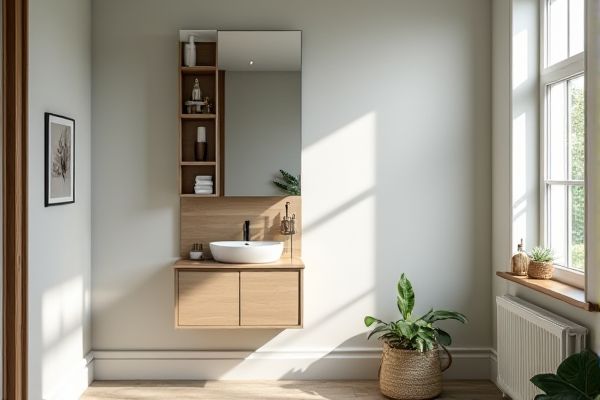
A corner cabinet maximizes storage by fitting snugly into room corners, making it ideal for kitchens or living areas, while a medicine cabinet is typically recessed or mounted in bathrooms to store toiletries and medications securely. Explore the article to discover which option best suits Your space and storage needs.
Table of Comparison
| Feature | Corner Cabinet | Medicine Cabinet |
|---|---|---|
| Location | Installed in room corners, often kitchen or bathroom | Mounted above bathroom sink or vanity |
| Purpose | Maximizes corner storage for dishes, appliances, or supplies | Stores medications, toiletries, and personal care items |
| Design | Varied shapes (L-shaped, diagonal) to fit corner space | Typically rectangular with mirrored door |
| Storage Capacity | Larger, multi-shelf space for bulkier items | Smaller shelves suited for small containers and bottles |
| Installation Height | Floor or wall-mounted, usually at waist to eye level | Wall-mounted at eye level for easy access |
| Material | Wood, metal, or laminate depending on style | Often metal or wood with glass mirror |
| Typical Room | Kitchen, bathroom, or pantry | Bathroom |
| Additional Features | Pull-out shelves, lazy susan options for efficiency | Mirrored door, built-in lighting, and electrical outlets |
Introduction to Cabinet Choices
Corner cabinets maximize space by fitting into room angles, ideal for kitchens or bathrooms needing efficient storage. Medicine cabinets offer specialized storage with mirrored fronts, commonly installed above sinks for easy access to toiletries. Both cabinet choices enhance organization but serve different functional and spatial purposes in home design.
Corner Cabinet Overview
Corner cabinets maximize unused space by fitting snugly into room corners, offering efficient storage for items like dishes, cookware, or pantry goods. Unlike medicine cabinets, which are typically wall-mounted and designed for storing personal hygiene products and medications, corner cabinets often have larger capacity and customizable shelving options. Your choice depends on available space and storage needs, with corner cabinets providing versatile solutions beyond the bathroom setting.
Medicine Cabinet Overview
A medicine cabinet is a specialized storage unit designed primarily for bathroom use, featuring mirrored doors and multiple shelves to organize toiletries, medications, and first-aid essentials efficiently. Compared to corner cabinets, medicine cabinets are typically wall-mounted at eye level, maximizing space in smaller bathrooms and providing easy access to daily healthcare items. Their construction often incorporates moisture-resistant materials to withstand bathroom humidity, enhancing durability and hygiene.
Space Efficiency Comparison
Corner cabinets maximize space utilization by fitting into underused angled areas, making them ideal for small kitchens or bathrooms seeking extra storage without clutter. Medicine cabinets, typically wall-mounted, offer compact, accessible storage specifically designed for personal care items, helping keep counters clear but occupying limited space. Your choice depends on whether you need broader storage capacity or specialized, space-efficient organization for daily essentials.
Storage Capacity Differences
Corner cabinets typically offer larger storage capacity due to their triangular shape, allowing for better utilization of otherwise wasted corner space in kitchens or bathrooms. Medicine cabinets are generally smaller, designed primarily for storing personal hygiene items and medications, limiting their storage capabilities. The increased depth and footprint of corner cabinets enable them to accommodate bulkier items compared to compact medicine cabinets.
Design and Aesthetic Appeal
Corner cabinets maximize space by fitting seamlessly into room corners, offering a unique, often triangular design that enhances room flow and visual interest. Medicine cabinets typically feature a sleek, mirrored front that blends functionality with minimalist aesthetics, ideal for modern bathrooms. Your choice depends on whether you prioritize spatial efficiency and distinctive shapes or streamlined, reflective surfaces for daily grooming.
Installation and Placement Considerations
Corner cabinets maximize unused space by fitting into room corners, requiring precise measurements to ensure a snug fit and easy door access. Medicine cabinets typically install flush with wall studs above sinks or vanities, demanding careful alignment to avoid plumbing or electrical conflicts. Choosing between them depends on your bathroom layout and the ease of accessing stored items.
Cost and Budget Factors
Corner cabinets generally offer more storage space but come with higher costs due to their specialized design and installation requirements. Medicine cabinets tend to be more budget-friendly, with standard sizes and easier installation making them ideal for smaller spaces. Your choice will depend on balancing available budget against the storage capacity and aesthetic impact you desire.
Maintenance and Durability
Corner cabinets often feature sturdy wood or laminate construction that requires periodic cleaning and occasional refinishing to maintain their durability, making them resilient against scratches and moisture when properly cared for. Medicine cabinets typically have metal or plastic frames with mirrored surfaces, which are easy to wipe clean but may be more prone to corrosion or chipping over time without gentle maintenance. Your choice should consider the maintenance effort you're willing to invest and the environment in which the cabinet will be used, as this impacts long-term durability.
Choosing the Right Cabinet for Your Needs
Corner cabinets maximize unused space by fitting snugly into room corners, offering deep storage ideal for kitchenware or bulk items, while medicine cabinets provide compact, wall-mounted storage specifically designed for bathroom essentials and first-aid supplies. Choosing the right cabinet depends on available space and function: corner cabinets suit kitchens or dining areas requiring larger storage capacity, whereas medicine cabinets are perfect for bathroom organization with easily accessible compartments. Consider the cabinet's dimensions, mounting options, and the types of items to be stored to ensure optimal usability and efficient space management.
 homyna.com
homyna.com